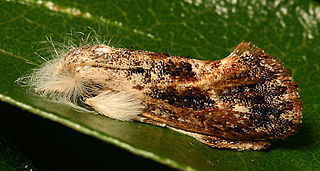
The common gallinule is a bird in the family Rallidae. It was split from the common moorhen by the American Ornithologists' Union in July 2011. It lives around well-vegetated marshes, ponds, canals, and other wetlands in the Americas. The species is not found in the polar regions or many tropical rainforests. Elsewhere, the common gallinule is likely the most commonly seen rail species in much of North America, except for the American coot in some regions.
Daphnia galeata is a small species of planktonic crustaceans. It lives in freshwater environments across a large area of the Northern Hemisphere, mostly in lakes.

Galeata is a comune (municipality) in the Province of Forlì-Cesena in the Italian region Emilia-Romagna, located about 70 kilometres (43 mi) southeast of Bologna and about 30 kilometres (19 mi) southwest of Forlì.

The helmeted manakin is a small species of bird in the family Pipridae, the manakins. It is found in the cerrado and pantanal of Brazil; also northeast Paraguay, and a border region of northeast Bolivia. Unlike most other manakins, it does not occur in regions with humid primary forest, but is found in various types of forest and woodland in semi-humid or fairly arid regions, but commonly near water. Until 1998 when the far rarer Araripe manakin was described, the helmeted manakin was the only member of the genus Antilophia.

The Moluccan flycatcher or dark-grey flycatcher is a species of bird in the family Monarchidae. It is endemic to Indonesia.

Acrolophus is a genus of moths in the family Acrolophidae, with, typically, great individual variation within species in color pattern, making field identification of many individuals difficult or impossible. It was described by Felipe Poey in 1832.

Acrolophus popeanella is a moth of the family Acrolophidae. It is found in the eastern United States, from New Jersey and Ohio south to Florida and west to Illinois, Nebraska and Texas.
Acrolophus fervidus is a moth of the family Acrolophidae described by August Busck in 1912. It is found in Costa Rica, Mexico and Texas.

Acrolophus arcanella is a moth of the family Acrolophidae. It is found in eastern North America.

The grass tubeworm or Texas grass tubeworm moth is a moth of the family Acrolophidae. It is found from Maryland to Florida and to Texas.
Acrolophus macrogaster is a moth of the family Acrolophidae. It is found in North America, including Arizona.
Walsingham's grass tubeworm moth is a moth of the family Acrolophidae. It is found in North America, including Alabama, Florida, Georgia, Illinois, Louisiana, Maryland, Mississippi, New York, Ohio, South Carolina, Tennessee, Virginia and West Virginia.
Acrolophus cockerelli is a moth of the family Acrolophidae. It is found in North America, including Arizona, Nevada, New Mexico, Oklahoma, Oregon and Texas.
Acrolophus echinon is a moth of the family Acrolophidae. It is found in Mexico.
Acrolophus mimasalis is a moth of the family Acrolophidae. It is found in the West Indies.
Acrolophus maculata is a moth of the family Acrolophidae. It is found in Brazil.
Acrolophus sinclairi is a moth of the family Acrolophidae. It is found in North America, including California, New Mexico and Texas.
Acrolophus numidia is a moth of the family Acrolophidae first described by Herbert Druce in 1901. It is found in Mexico.
Acrolophus satyrisca is a moth of the family Acrolophidae. It is found in Colombia.
Acrolophus walsinghami is a moth of the family Acrolophidae. It is found in Puerto Rico.







